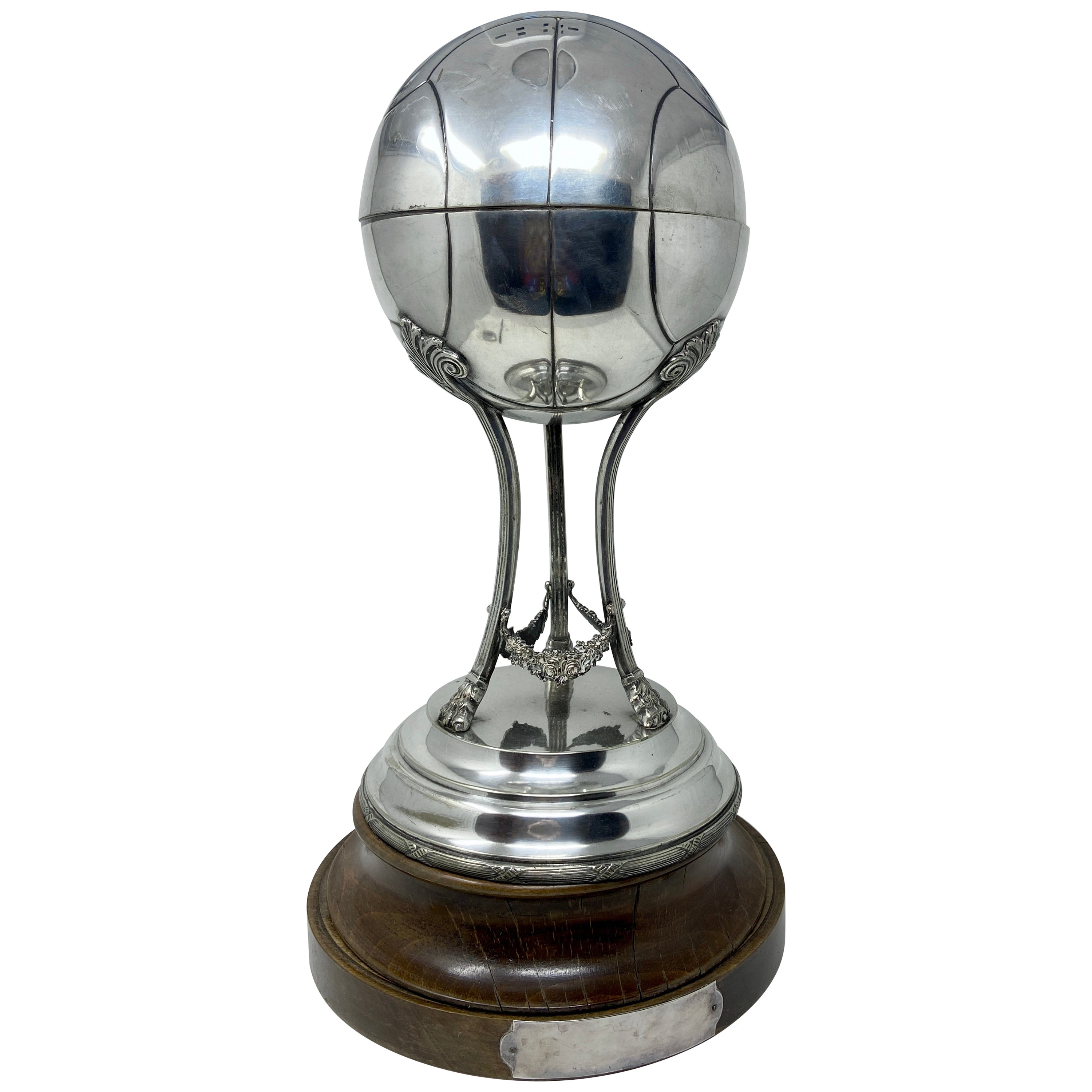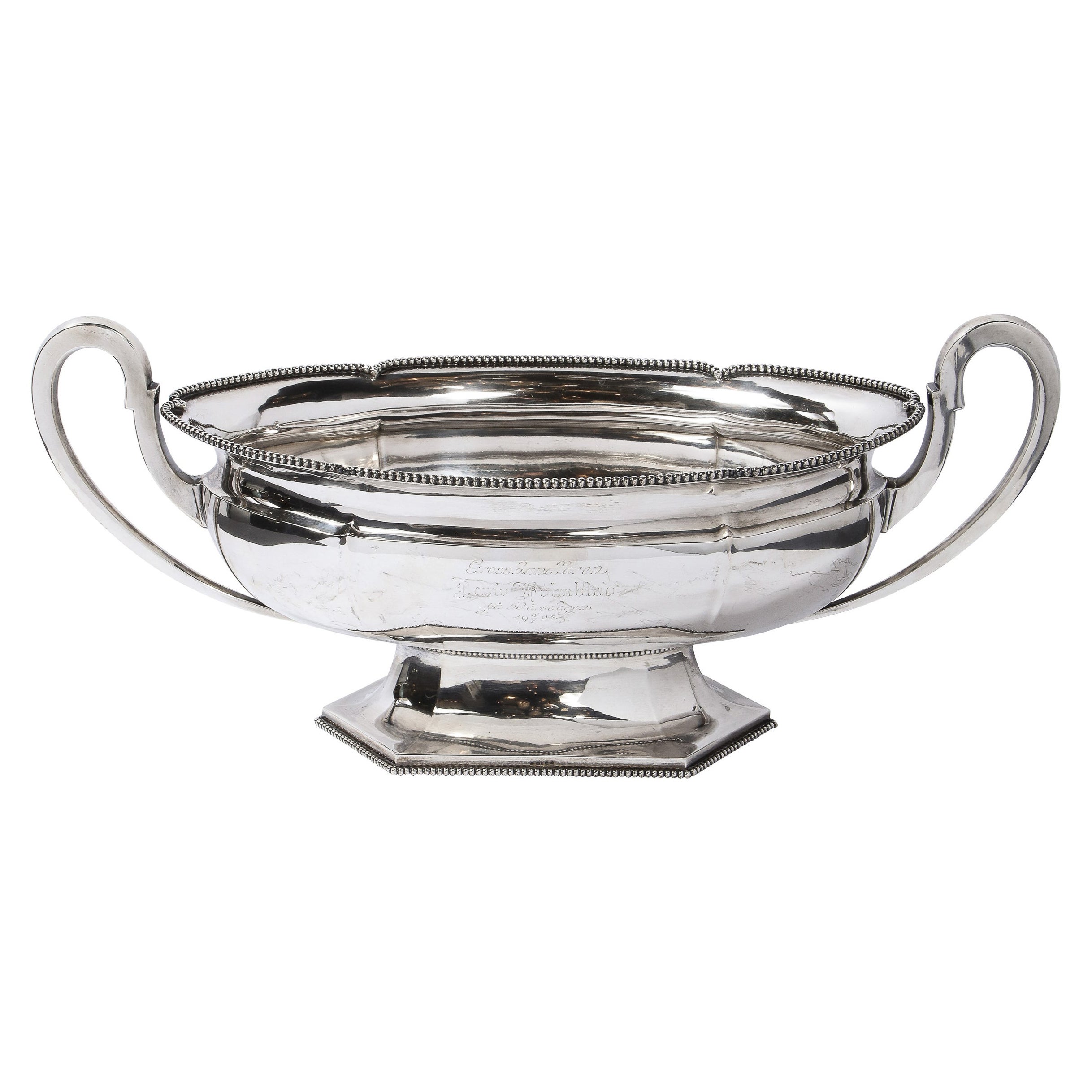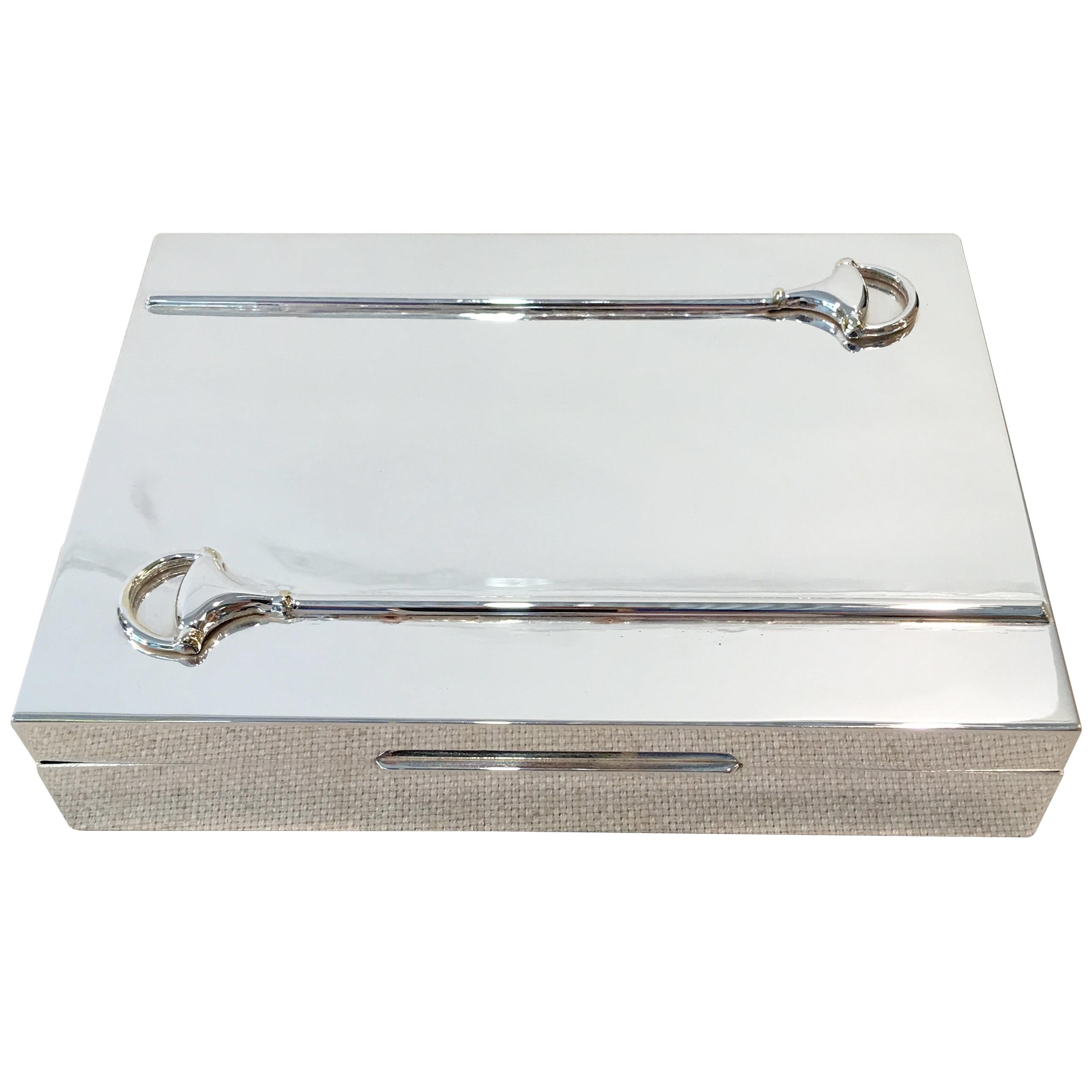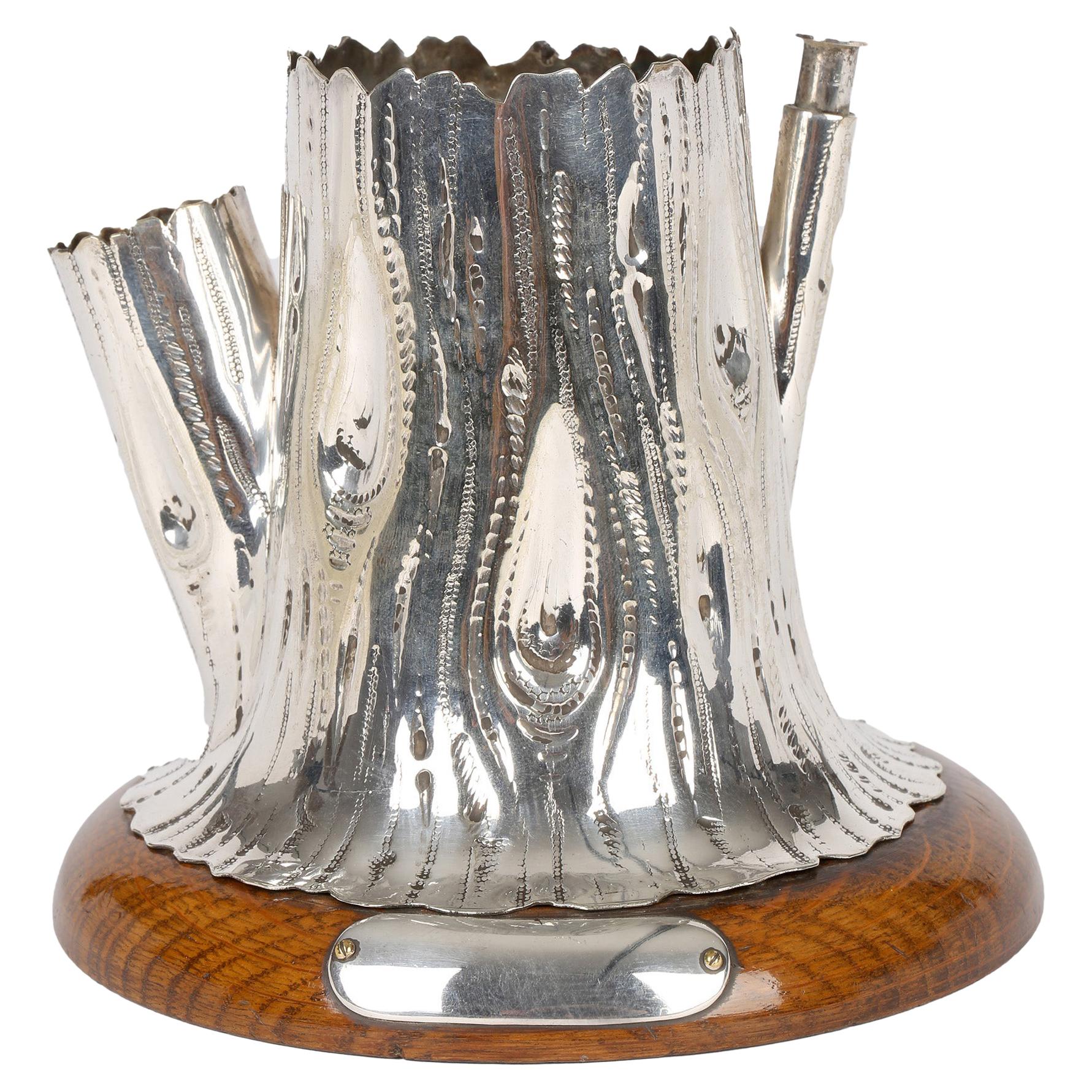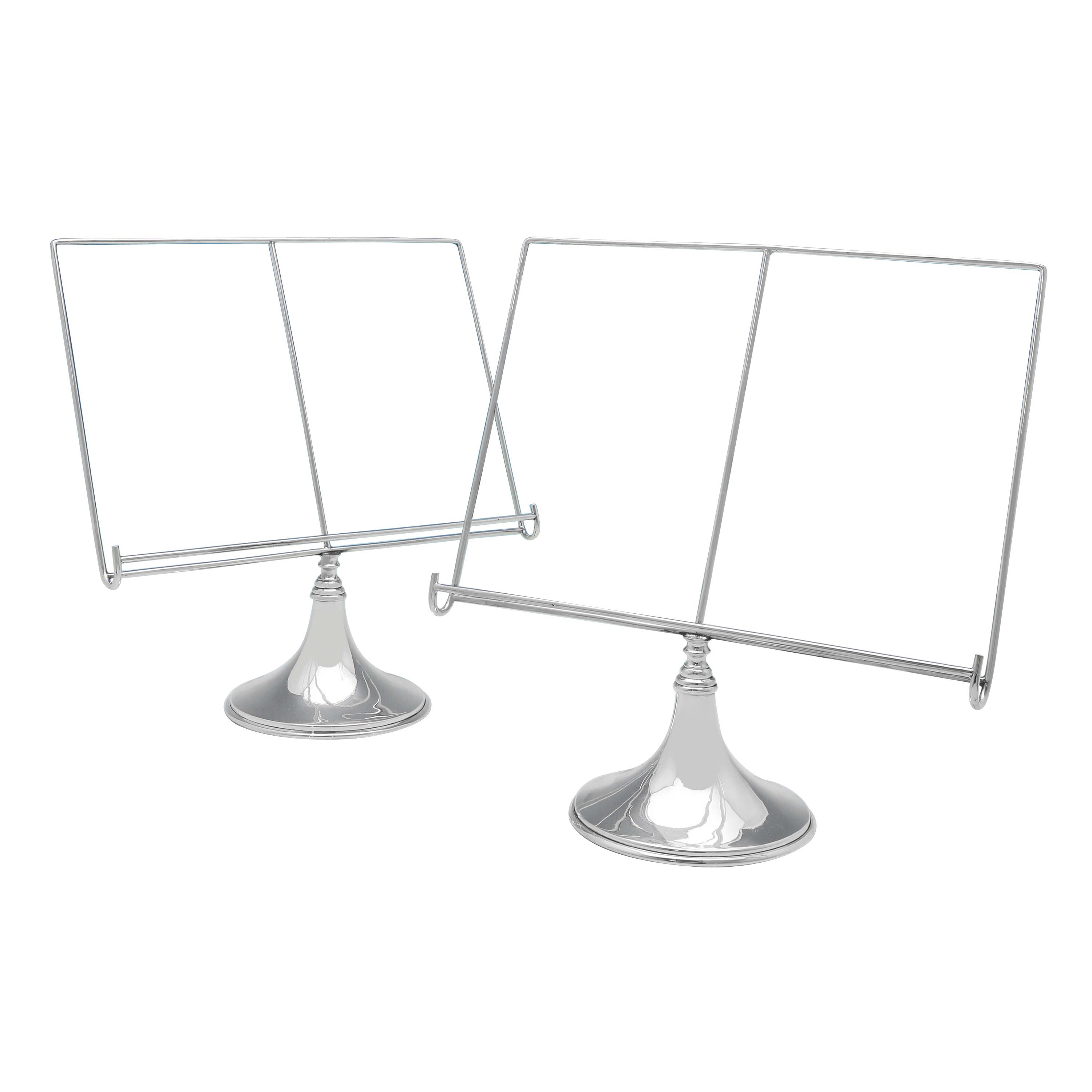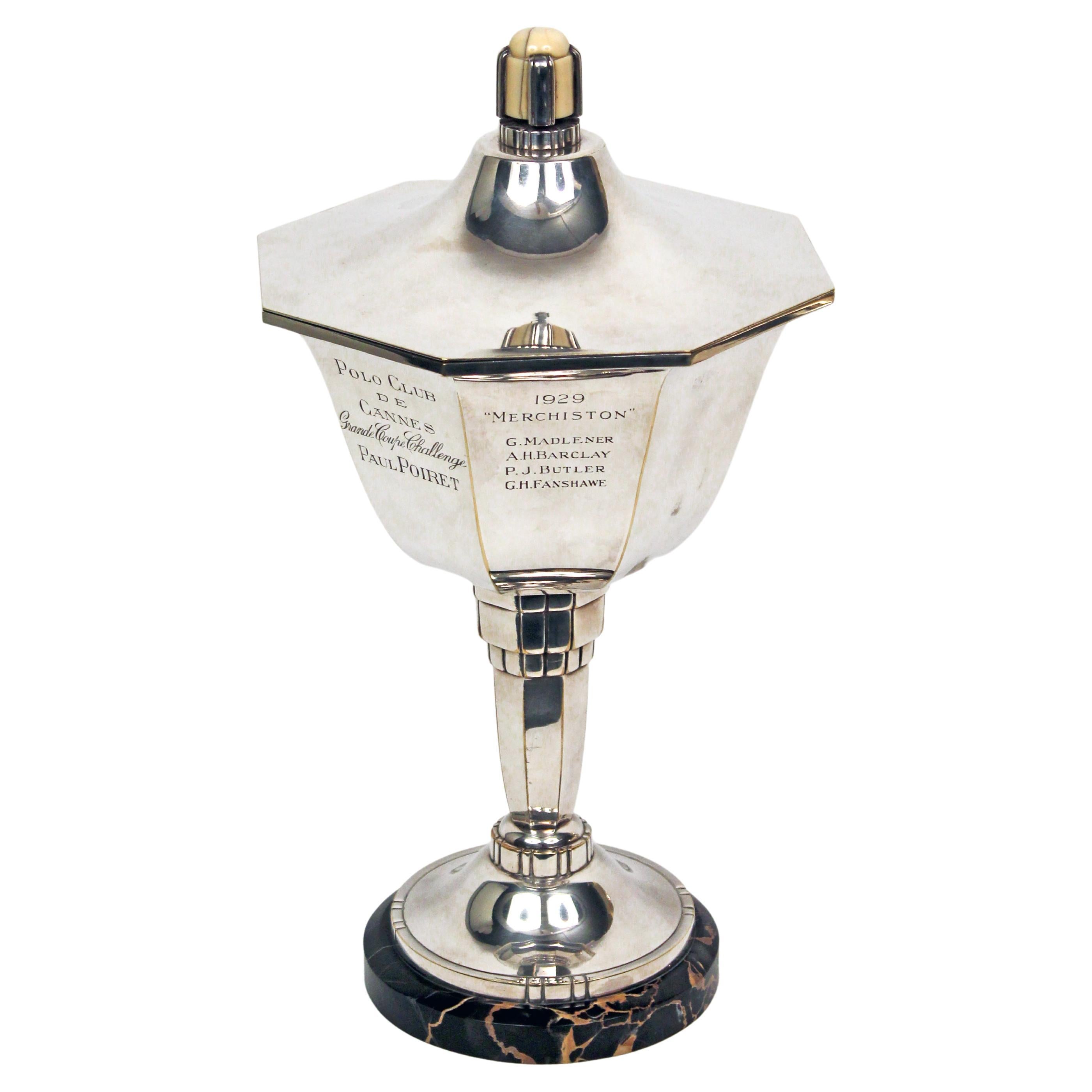Items Similar to Silver Plated Fishing Reel Trophy
Want more images or videos?
Request additional images or videos from the seller
1 of 5
Silver Plated Fishing Reel Trophy
About the Item
This silver trophy was designed to celebrate the winner of an angling competition. Three fishing rods with large reels intersect over one another, forming a three-pronged base for the trophy. Looped onto the rods is a wreath, signifying victory for the recipient of the trophy. The chalice of the trophy is clear and nondescript, free of any markings or initials. Well maintained and sturdy, this is an excellent example of antique silver craftsmanship.
Sportfishing began in earnest in 15th century England with the publishing of "The Treatyse of Fysshynge with an Angle." Written by Dame Juliana Berner, the article was one of the first to promote fishing for pleasure instead of food. The publishing of the article is widely considered to be the birth of modern angling.
Further developments were collected and released in "The Art of Angling" by Richard Bowlker in 1747. While "The Treatyse of Fysshynge with an Angle" is considered the birth of modern sportfishing, "The Art of Angling" marks the start of modern fly fishing techniques including dressing flies for certain species and specialized casting techniques for different situations. "The Art of Angling" was followed by "Vade Mecum of Fly-Fishing Trout" in 1846 which was the first published work to describe how to tie a dry fly.
The 18th and 19th centuries saw much more progress towards modern fly fishing with Spanish silkgut replacing horsehair for leaders and lines, the development of reels, the appearance of guides on rods, and the tapering of lines. Fly fishing continued evolving mostly in the United Kingdom with the emergence of angling clubs, several new books on technique and how to tie flies, and new methods for fishing thanks to the weeds that grew close to many British riverbanks. The Victorian era of fly fishing is also the era fly fishing jumped from a practical form to haul in dinner to an art.
This trophy would look fantastic on a bookshelf, in an office, or a well-appointed game room. It also can serve as a display for flowers or small dried arrangements, making it a very versatile design element.
Condition:
Overall very good condition. No severe wear is visible, with bright and clean silver plating. Dimensions: 8 1/2" H x 3 3/4" W x 3 3/4" D.
About the Seller
4.9
Platinum Seller
These expertly vetted sellers are 1stDibs' most experienced sellers and are rated highest by our customers.
Established in 2010
1stDibs seller since 2011
398 sales on 1stDibs
Typical response time: <1 hour
- ShippingRetrieving quote...Ships From: Colorado Springs, CO
- Return PolicyA return for this item may be initiated within 10 days of delivery.
More From This SellerView All
- Silver Plated Airplane-Themed Tableware, circa 1910Located in Colorado Springs, COThis is a beautiful silver-plated egg cup and spoon set with an airplane motif, dating to the early 1910s. The set includes four matching footed egg cups. The cups sit upon the stack...Category
Vintage 1910s English Art Deco Sheffield and Silverplate
MaterialsSilver
- Hallmarked Silver Plated Keepsake Box, Sheffield, UK, circa 1900Located in Colorado Springs, COOffered is a stunning silver plated keepsake box dating to 1900, with associated hallmark. This small box includes a wooden interior with two slots and a blank square on top where initials could have been engraved. A well maintained, elegant piece, this antique silver box is an excellent addition to any silver or home decor collection. Trinket or keepsake boxes have taken on many forms since their first conception in ancient times. However their purpose remains the same; to store jewelry and other items precious to the owner. Originally, these boxes were used specifically for jewelry. These were in common use as early as 5000 BC in Ancient Egypt, when the majority of Egyptians, both male and female, wore jewelry. Boxes were used to keep these gemstone encrusted items safe. In Ancient Rome, jewelry was a status symbol. Rings and brooches were utilized to represent ones status in society. Again, boxes were needed for security and storage purposes. Finding early examples of these are quite rare. Victorian and Edwardian examples of trinket boxes are far more common. This is because owning jewellery was a luxury until the Victorian era- let alone possessing so much a box was needed to store it all. Fine jewelry and other items became available to the masses after the industrial revolution due to the reduction in production costs. This led to a demand for trinket boxes, which were much smaller than jewelry boxes and therefore better suited to the needs of the middle class who did not yet possess an abundance of jewelry. In Victorian households, collectables and other items of interested were also stashed inside these boxes. This is why they are known as trinket or keepsake boxes, rather than just jewelry boxes, although of course jewelry was also stored in them. Trinket boxes were produced in large numbers around this time. Many were lined with colored plush or velvet or rich wood. More elaborate designs had interior divisions and trays for rings and other pieces of jewellery. It was also common to see trinket boxes so small that they could only contain one item, such as a single ring. Ornate exteriors were created to reflect the value of the trinket boxes contents. The Edwardian era saw the introduction of new styles of trinket box. These included small circular or oblong boxes...Category
Antique Early 1900s English Art Deco Decorative Boxes
MaterialsSilver
- Hallmarked Silver Plated Keepsake Box, Sheffield, Uk, Circa 1900Located in Colorado Springs, COOffered is a stunning Sheffield silver keepsake box dating to 1900, with associated hallmark. This small box includes a clean interior and rounded corners. The box is free of names or initials, but would have been used to house keepsakes such as jewelry or cufflinks. A well maintained, elegant piece, this antique silver box is an excellent addition to any silver collection. Trinket or keepsake boxes have taken on many forms since their first conception in ancient times. However their purpose remains the same; to store jewelry and other items precious to the owner. Originally, these boxes were used specifically for jewelry. These were in common use as early as 5000 BC in Ancient Egypt, when the majority of Egyptians, both male and female, wore jewelry. Boxes were used to keep these gemstone encrusted items safe. In Ancient Rome, jewelry was a status symbol. Rings and brooches were utilized to represent ones status in society. Again, boxes were needed for security and storage purposes. Finding early examples of these are quite rare. Victorian and Edwardian examples of trinket boxes are far more common. This is because owning jewellery was a luxury until the Victorian era- let alone possessing so much a box was needed to store it all. Fine jewelry and other items became available to the masses after the industrial revolution due to the reduction in production costs. This led to a demand for trinket boxes, which were much smaller than jewelry boxes and therefore better suited to the needs of the middle class who did not yet possess an abundance of jewelry. In Victorian households, collectables and other items of interested were also stashed inside these boxes. This is why they are known as trinket or keepsake boxes, rather than just jewelry boxes, although of course jewelry was also stored in them. Trinket boxes were produced in large numbers around this time. Many were lined with colored plush or velvet or rich wood. More elaborate designs had interior divisions and trays for rings and other pieces of jewellery. It was also common to see trinket boxes so small that they could only contain one item, such as a single ring. Ornate exteriors were created to reflect the value of the trinket boxes contents. The Edwardian era saw the introduction of new styles of trinket box. These included small circular or oblong boxes...Category
Antique Early 1900s British Art Deco Decorative Boxes
MaterialsSilver
- Sterling Silver Cricket Trophy, circa 1923Located in Colorado Springs, COThis is a handsome sterling silver trophy dating to circa 1923. Detailed in raised relief on the the goblet-shaped trophy is an energetic cricket scene. It shows a cricket batter as ...Category
Vintage 1920s British Sports Equipment and Memorabilia
MaterialsSterling Silver
- Silver Sheffield Cricket Sugar Jar, circa 1900Located in Colorado Springs, COThis is an exquisite early 20th century crystal jar with a silver lid and spoon. The lid's top is fashioned after a cricket wicket. The jar sits on a round silver base with decorativ...Category
Antique Early 19th Century British Sheffield and Silverplate
MaterialsSilver
- “Salmon Fishing, " Signed Proof by Douglas Adams, Antique Limited Print, 1892By Douglas AdamsLocated in Colorado Springs, COThis is the 1892 artist proof edition of 200 signed by the artist, Douglas Adams. Douglas Adams (1853-1920) was a London based landscape painter exhibiting at various galleries betwe...Category
Antique 1860s English Prints
MaterialsPaper
You May Also Like
- Antique English Silver Plated Soccer TrophyLocated in New Orleans, LAAntique English Silver Plated Soccer Trophy.Category
Antique 19th Century English Sports Equipment and Memorabilia
MaterialsSilver Plate
- Swedish Art Deco Streamlined Silver Plate Beaded Trophy BowlLocated in New York, NYThis elegant Art Deco trophy bowl was realized in Sweden in 1924. It offers a sculptural oval body sitting on a hexagonal faceted base with beaded detailin...Category
Vintage 1920s Swedish Art Deco Centerpieces
MaterialsSilver Plate
- Gucci Italy Silver Plated Rare Snaffle Box Lined with SatinwoodBy GucciLocated in Hanover, MAExtremely rare vintage 1970 Gucci Italy silver plated horse-bit decorated box lined with satinwood; hinged lid with stirrup snaffle motif and raised lip so airtight when closed. Rest...Category
Vintage 1970s Italian Mid-Century Modern Sheffield and Silverplate
MaterialsSilver Plate
- Antique English Silver Plated Tree Trunk Shaped Cigar or Cheroot StandLocated in Bishop's Stortford, HertfordshireAn unusual English late Victorian antique presentation silver plated tree trunk shaped cigar or cheroot stand with cutter dating from 1889. The sta...Category
Antique 1880s English Late Victorian Sheffield and Silverplate
MaterialsSilver Plate
- Asprey, Pair of Antique Silver Plate Music Stands, Made Circa 1910By Asprey International LimitedLocated in London, LondonMade in London circa 1910 by Asprey & Co. Ltd., this stylish pair of Antique Silver Plate Music Stands, are plain in design. Each music stand measures 13.5"(34 cm) tall, by 13.5"(34 ...Category
Vintage 1910s English Edwardian Sheffield and Silverplate
MaterialsSilver Plate
- Art Deco Silver Plated Trophy by Paul Poiret, Dated 1929By Paul PoiretLocated in Miami, FLArt Deco silver plated trophy dated 1929 designed by Paul Poiret, made of silver plated metal a details and marble. Made in France Dated: 1929.Category
20th Century French Art Deco Centerpieces
MaterialsSilver Plate
Recently Viewed
View AllMore Ways To Browse
Silver Initials
W Silver Mark
Initialed Plates
Silver Dressing
Spanish Plate Large
Silver Trophies
Silvered Trophy
Silver Trophy
Antique Clear Glass Plates
Large Antique Trophy
Large Antique Trophies
18th Early 19th Century Plates
Art Deco Trophies
Art Deco Trophy
Victorian Trophy
Bookshelf Antique
Antique Bookshelfs
Antique Bookshelf
